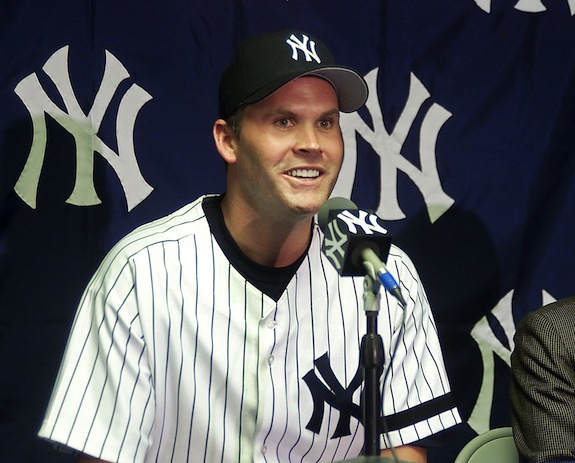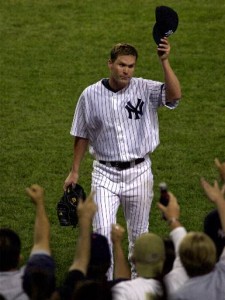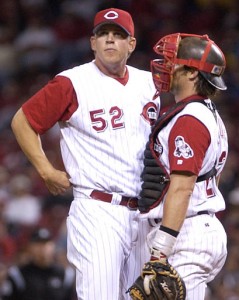On the heels of two consecutive World Championships and three in four years, the 2000 Yankees limped into July with a pedestrian 39-36 record that had them three games back of the Blue Jays. The team was in clear need of another bat and another starting pitcher, and Brian Cashman addressed the first issue when he acquired David Justice from the Indians in late-June. Just about three weeks before the trade deadline, Cashman addressed the need for a starting pitcher, shipping four prospects to the Reds for left-hander Denny Neagle and minor league outfielder Mike Frank.

“We like these [prospects], but we’ve made the decision to go for it,” said Brian Cashman shortly after the trade. “Denny Neagle is the guy we wanted. We feel he was the best pitcher available on the market. He has postseason experience. He’s healthy. He’s been successful. And a left-hander at Yankee Stadium—all those attributes played a part in it.”
The Yankees had first hand knowledge of Neagle; he threw six innings against them for the Braves in the 1996 World Series. Those were just two of his ten career postseason appearances (up to that point), which featured a 3.09 ERA with a .249 wOBA against in 35 innings. Before the trade he’d pitched to a 3.52 ERA (4.65 FIP) in 18 starts with the Reds, and from 1995 through 1999 he owned a 3.46 ERA (3.97 FIP) in just about 1,000 innings. There were obvious reasons to expect Neagle to be successful for the Yankees, and at the outset he was.
In his first start for New York, Neagle tossed eight innings of one run ball against the Phillies and then followed that up with complete game, one run effort against the then-Devil Rays. His next two outings were good but not great (7 IP, 4 R against both the Twins and Royals), but it all started to go downhill from there. The Mariners hung seven runs on Neagle in 5.2 innings next time out, capped off by a Carlos Guillen grand slam in the sixth. Five days later he gave up six runs to the Angels, recording just five outs. Neagle received a brief reprieve after shutting out the Angels for 6.2 innings in his next start, but he went on to allow 36 runs and ten homers in his final eight starts of the season, covering 45.2 innings. His season ERA had risen from 3.52 with the Reds to 4.52 overall.

Neagle was on the team’s ALDS roster but did not pitch in the series. Roger Clemens and Andy Pettitte both pitched on three days rest as the Yanks topped the A’s in five games. Those two starts, plus the need for third starter Orlando Hernandez to pitch in relief during Game Five, forced Joe Torre to start Neagle in Game One of the ALCS. He performed pretty well, holding the Mariners to two runs in 5.2 innings, but the Yankees didn’t bother to score and lost by the score of (yep) 2-0. Neagle then started Game Five with the Yanks leading the series three games to one, surrendering one run in 4.1 innings before Jeff Nelson relieved him and allowed a pair of inherited runners to score (and then some).
The Yankees eventually won the ALCS in six, advancing to the Subway Series. Pettitte, Clemens, and El Duque got the ball in Games One, Two, and Three, handing a two games to one series lead off the Neagle for Game Four. On another short leash, he held the Mets to two runs in 4.2 innings, but the Yankee bullpen made an early 3-2 lead stand up. The Yanks eventually won the series as you know, and Neagle was allowed to leave as a free agent after the season, signing that five-year, $51M contract with the Rockies. With the draft picks they received as compensation, the Yanks selected Bronson Sardinha and Jason Arnold.
All told, the Yanks received 91.1 innings out of Neagle, who pitched to a 5.81 ERA (5.23 FIP). His first playoff start was good but the other two were no better than acceptable, and all together Neagle was worth just 0.2 bWAR in pinstripes. The Yankees also assumed the $2.55MM left on his contract, a pittance by today’s salary standards. Mike Frank, the other player they received in the trade, never reached the big leagues with the Yankees, hitting .249/.329/.393 in 572 plate appearances with Triple-A Columbus in 2000 and 2001. He signed with the Cardinals as a minor league free agent after that, and has been out of baseball since 2002.
As for Cincinnati, they received a hodgepodge of four highly regarded prospects in the transaction. The headliner was 1998 third round pick Drew Henson, who had been rated the 24th best prospect in the game by Baseball America before the season. He played just 16 games in the Reds’ farm system that season, going 11-for-64 with eight doubles, a homer, four walks and 25 strikeouts. Cincy then traded him back to the Yankees (with outfielder Michael Coleman) after the season for another top prospect, outfielder Wily Mo Pena.
Left-hander Ed Yarnall was the second key piece for the Reds. Baseball America ranked him the 55th best prospect in the game before the 2000 season, and of course the Yankees originally acquired him in the ill-fated Mike Lowell trade. Yarnall had appeared in seven total games with the Yanks in 1999 and 2000, though he predictably struggled (14 K, 13 BB in 20 IP). Cincinnati never received even that much production out of him at the big league level; Yarnell made 11 starts for the Reds’ Triple-A affiliate after the trade (3.86 ERA) before bolting for Japan after the season. He returned to the U.S. in 2003, but not with the Reds and never to reach the majors again.
The third top prospect that headed to Cincinnati was outfielder Jackson Melian, who Baseball America ranked the 72nd best prospect in the game before the season. The then 20-year-old hit .236/.309/.398 in a year-and-a-half with Cincy’s various minor league affiliates, eventually getting plucked off waivers by the Brewers before the 2002 season. Melian never reached the big leagues, though he bounced around in the minors (including a second stint with the Yankees) through 2008.

The fourth player was not a top 100 prospect, just a Single-A right-hander named Brian Reith. He was the only player Cincinnati received in the trade that actually managed to play for them at the big league level, throwing 127.2 innings (5.92 ERA) spread out from 2001 through 2004 before being claimed off waivers from the Phillies. His Reds career was worth -1.4 bWAR.
Neagle has long been considered a bust in pinstripes, but the Yankees got far more out of him than the Reds got out of the players they received. Other than the payroll savings and the secondary deal for Pena, Cincinnati received almost no return for two-plus months of their best starting pitcher. Neagle pitched poorly in New York, but he helped the team win a World Championship, which is exactly why they brought him in. It’s certainly not a clear win, but I’d rather have been on the Yankees end of the deal.
Leave a Reply
You must be logged in to post a comment.